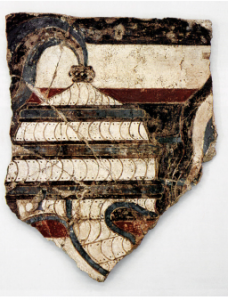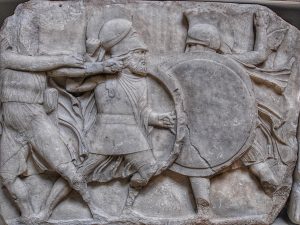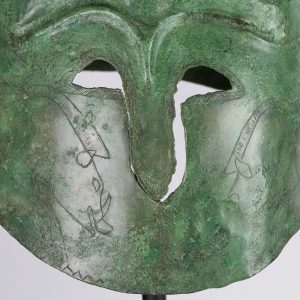The Boar helmet has been a potent symbol of warrior prowess throughout the Indo-European world. This is not surprising considering the Boar, in short, is a symbol of the transformative powers of meeting the struggle of life head on. This article will be a short overview of this magnificent war talisman, the Boar helmet.
 The earliest evidence we have of Boar helmets comes from Mariupol in the Ukraine, dating to around 2000BC. Mariupol is situated just north of the Black sea, located in the Pontic Steppe. This area is of course where Yamna culture developed, who many consider to be the originators of the Indo-European languages. Given the dating of this artefact, though, it is more likely to belong to the Catacomb culture, which appears to of developed at least in part out of Yamna culture. This early Boar helm is simple in its construction, consisting of slithers of Boar tusks added to a leather cap. To the right is an artistic impression of how this helm may of looked when it was originally made.
The earliest evidence we have of Boar helmets comes from Mariupol in the Ukraine, dating to around 2000BC. Mariupol is situated just north of the Black sea, located in the Pontic Steppe. This area is of course where Yamna culture developed, who many consider to be the originators of the Indo-European languages. Given the dating of this artefact, though, it is more likely to belong to the Catacomb culture, which appears to of developed at least in part out of Yamna culture. This early Boar helm is simple in its construction, consisting of slithers of Boar tusks added to a leather cap. To the right is an artistic impression of how this helm may of looked when it was originally made.
The simple construction would have offered little protection and was probably considered more of a status symbol. Boars, being a notoriously brave and bold animal, were not an easy opponent for a bronze age hunter. The Boars’ nature, unlike most “prey” animals, is to charge its attacker, bringing his full weight and lethal tusks to bare down upon the aggressor. Given the dangers involved, Boar tusks would have been a rare commodity, that only the brave or wealthy could obtain. This would have given Boar tusks a high status appeal, for the hunter a symbol of skill, and for the affluent one of wealth. It is also possible, given my interpretation of the Boar as a symbol not only of adversary, but also one of transformation and birthing, that these helmets may have been used in an initiation process. Whatever the true meaning behind this helmet was, we know that it must have carried with it a powerful status, which continued to hold meaning for millennia, as we will see.
The next example in history comes from the Island of Aegina within the Saronic Gulf in the Aegean Sea, dating around 1800bc. At this time the Island of Aegina is considered to have significant influence from Minoan civilisation, given the findings of Minoan ceramics at around 2000bc. The Boar helmets’ appearance on the Island, though, offers up an interesting enigma, given its roots in the Pontic Steppe. The helm itself (below left) is much more sophisticated in design and is clearly a precursor to the type of Boar Tusk helm found in the slightly later Mycenaean Greek era. Its appearance in the Aegean sea before mainland Greece adds to the enigma of exactly how the Pontic steppe cultures interacted and influenced these early Mediterranean cultures.
As mentioned, this basic design (above left) is almost certainly the influence for later Mycenaean Greek Boar Helmets Many examples are found from this era (above centre) and elaborate frescos often depict warriors with such an adornment (above right). The Boar Helmets of this age consisted of anything up to 140 individual Boar tusks to make and would have required a high level of skill to produce. The fact that they appear to be preferred over metal alternatives, even though they offer less protection, only adds to their status as a powerful talisman of the hero. It is highly likely from accounts by Homer that these helmets were often passed down as heirlooms by elite warriors. Because of its high status and symbolic meaning, this style of helmet remained a consistent aspect of the heroic Mycenaean culture, from beginning to end.
The next place we find the Boar helm is a controversial one – the Corinthian helmet. The Corinthian helmet is probably the helmet everyone thinks of when imagining an ancient Greek warrior. It was a helmet used by the formidable Hoplite of Ancient Greece (Below left) and of course is the helmet that adorns the glorious Goddess Athena (Below right). This Style became popular after the Greek dark ages that followed the Mycenaean period, in the Archaic Greek period.
Now you may be thinking, “this is all good and well, but what have they got to do with boars?”. Well, the plume that is often adorning these helmets is commonly believed to be a representation of a horse’s mane. While it is true that they are often made out of Horse hair, or in some cases bronze (below right) like the rest of the helm, I believe there is a case that they actually represent a Boars mane. While a horse mane can be trimmed to resemble that of a Corinthian helmet, a Boars mane can, in certain subspecies, look identical with no alterations needed. Below is picture of a Boar with mane and a Corinthian helmet; notice the tapering that occurs naturally on the Boar mane, also visible in the helm.
Whether or not the mane was a representation of a Boar’s mane in some or all of these types of helmets, boars were associated with one of its descendants, the Apulo-Corinthian helmet. This oddity of a helmet, unlike the Corinthian helmet, was not a full faced helmet, although in many cases it still had both Eye and mouth openings. It was worn more like a cap on top of the head, but kept design features of the full faced version. It appears to have developed out of the combat style of wearing the Corinthian helmet, as seen on statues of Athena. This style of helmet was developed in the south east of Italy (the heel) in around 500bc. This area of Italy had been the focus of Greek attacks, most notably of the Spartans, and had in most cases put up heroic resistance. There does, however, seem to have been a merging of cultures over time, with the Pelugians copying Greek architecture and style of military equipment. Despite their oddity, the connection to Boars cannot be disputed. Many examples found have, on what would be the cheek areas of the full faced version, but now situated on the brow, depictions of facing Boars (see below). Cheek armour engravings were also common on Greek Corinthian helmets but varied greatly, whereas on the Apulo-Corinthian Helmets most engravings are of Boars. There is still, though, little known about this interesting little area of Italy, just how this merge of cultures came about and if it had any influence on the later rise of Rome.
As we can see, the Boar helmet motif has been a powerful and persistent one through out the ages. In part two I will cover the Boar helm as it moves through time, with a focus on the more northern realms of the Celts and the Germanic tribes. The symbol itself is often reduced to simply that of a symbol war, citing the above examples as evidence. For me this symbol is far deeper and goes to the very root of our folk consciousness. Be sure to check for new articles detailing this and when they are up I will add them below.
Originally on Mimirsbrunnr.com
Source Article from http://www.renegadetribune.com/boar-helmet2000bc-500bcthe-pontic-steppe-italy/
 RSS Feed
RSS Feed















 March 2nd, 2018
March 2nd, 2018  Awake Goy
Awake Goy 








 Posted in
Posted in  Tags:
Tags: 













